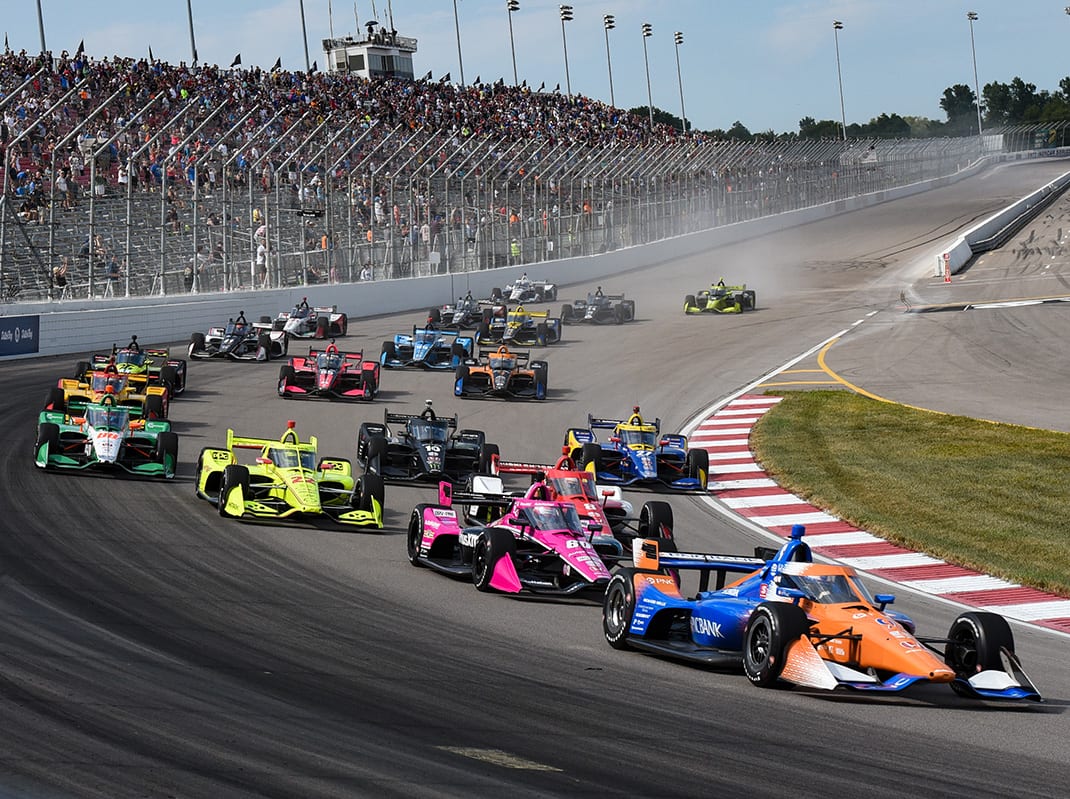In a year when the COVID-19 pandemic left a trail of broken dreams and broken lives, IndyCar and NASCAR had to dramatically revise schedules simply to have a season.
Out of necessity, both sanctioning bodies used doubleheaders to help make up races that were lost to the pandemic.
In order to have a 14-race season, the NTT IndyCar Series had to turn all but three of its weekends into doubleheaders. Road America, Iowa Speedway, World Wide Technology Raceway and Mid-Ohio Sports Car Course all hosted twin bills with Indianapolis Motor Speedway scheduled for an Oct. 2-3 double dip on its road course.
“I think we’re in good shape,” Penske Entertainment CEO Mark Miles told SPEED SPORT. “If you look at every live entertainment, every sports league, music, the rug has been sort of pulled out from under us. The question we face every day is, in an incredibly unpredictable context, how do we navigate our way forward?
“It required us being agile, I think, dealing with a fluid situation, being flexible. When I say us, I mean IndyCar, IMS, all our teams, our promoters, broadcasters. Sometimes we talk about thinking about what’s around the next turn. In this case, we don’t know where the next turn is let alone what’s around it.
“I think we’ve done really well.”

The reason IndyCar has done well is because of the doubleheaders. Without them the season would have been in shambles and teams would have had to forfeit sponsorship money.
“The doubleheaders have been a key,” Miles said. “It’s very difficult to stand up a new race in a new place on an unscheduled weekend. It’s much more feasible to add a second race on a weekend at a place where we’d already planned to race. That’s helped the promoters who have had the benefit of having a second race added to their program. It’s pretty efficient for all of us, IndyCar, NBC, and of course the teams. So that’s been really important.
“I think the teams have been remarkably resilient. I think they’re in pretty good shape,” Miles added. “I’m sure there will be conversations all of us will have with our sponsors and other partners. Most of those are sort of by informal understanding: Let’s wait till the end of the year and we’ll take stock and have any kind of a true-up that might be appropriate.
“For the most part, I think we’re delivering really good value. I think that’’s perceived by our partners. We’re certainly making the best of a difficult situation.”
NASCAR had an even more pressing need to create doubleheader weekends, or by running a Sunday race followed by a midweek race at the same venue, or a nearby venue in order to keep a 36-race season.
Both IndyCar and NASCAR shut down their seasons on March 13 when COVID-19 began taking a grip on the United States.
NASCAR returned to action at Darlington (S.C.) Raceway on May 17 and raced there again on May 20. Two races were also run in a four-day period at Charlotte Motor Speedway.
The first doubleheader for the NASCAR Cup Series came June 27-28 at Pocono Raceway, which was the only doubleheader on the sanctioning body’s original schedule.
August became the month of doubleheaders with the Cup Series racing on consecutive days at Michigan Int’l Speedway and Dover (Del.) Int’l Speedway. As a result, NASCAR ended its regular season on time and began its 10-race playoff run with the Southern 500 at Darlington.
The success of the doubleheaders may have also created a blueprint for schedules moving forward. More races can be held in a more condensed period of time where both IndyCar and NASCAR can crown a champion before the leaves begin to change color in the fall.
It can also help teams save money during this ever-challenging economic climate.
“It saves costs, there is no question of that,” IndyCar team owner Bobby Rahal told SPEED SPORT. “You have to drive value for our sponsors and opportunities for our sponsors. Somehow that would have to all be worked out.
“I don’t mind the concept of double races. Certainly, Elkhart Lake is a track that can easily handle that. Mid-Ohio probably. I’m not sure of some of the others. I don’t know if you’d want two races on a street race weekend, for example.”
Miles agreed.
“It’s clear that it’s efficient, efficient for a promoter who has a lot of costs already for just the one event,” he said. “If you can do two and bring in more fans, that can make some economic sense. It’s efficient for the teams, even if it does create other strains for teams. It’s efficient from a television point of view in terms of the production costs and overhead.
“I think it’s a mistake to think our objective is to see how many doubleheaders we can do,” Miles added. “It’s been a terrific way this year to fill in where we lost some races due to COVID and really didn’t have an opportunity to reschedule them. But we have a lot of really great venues, a lot of great promoters. Accordingly, I think we believe being in more markets where the races work is important to us.
“I just don’t want the idea that we’re trying to see how many we can do to get misconstrued.”
Click below to continue reading.
